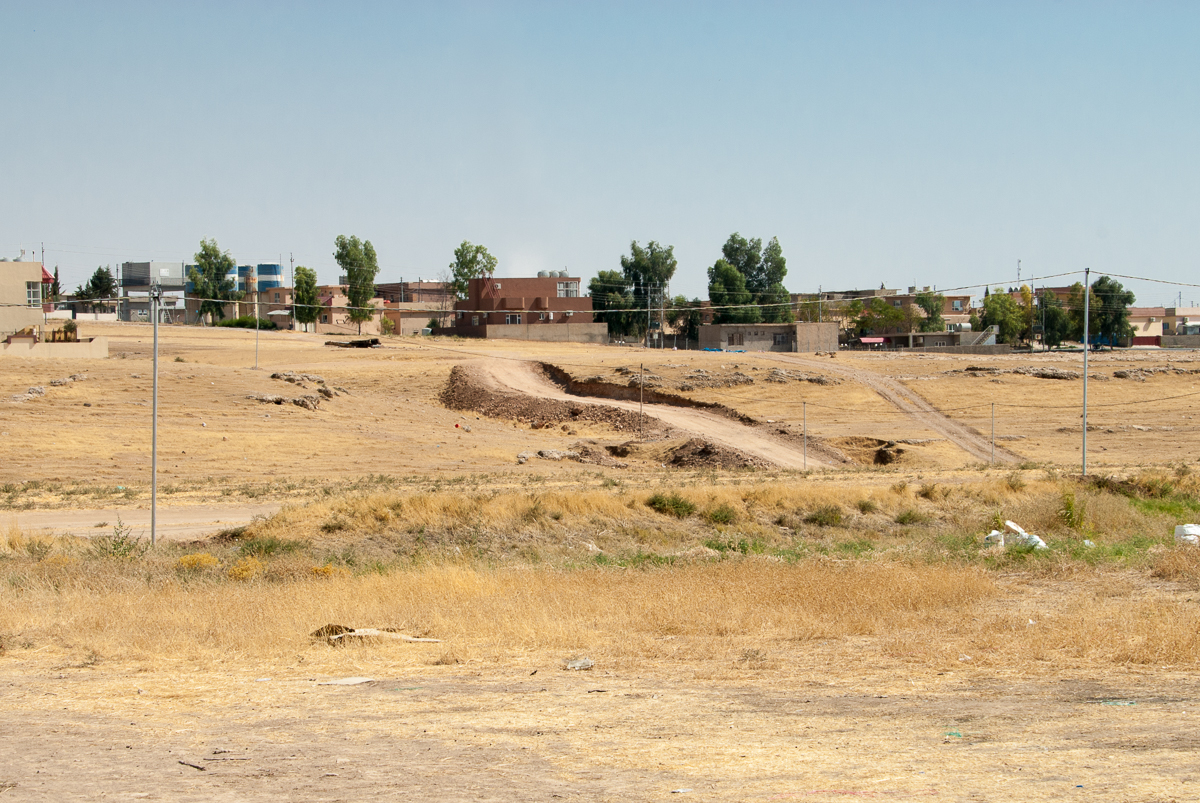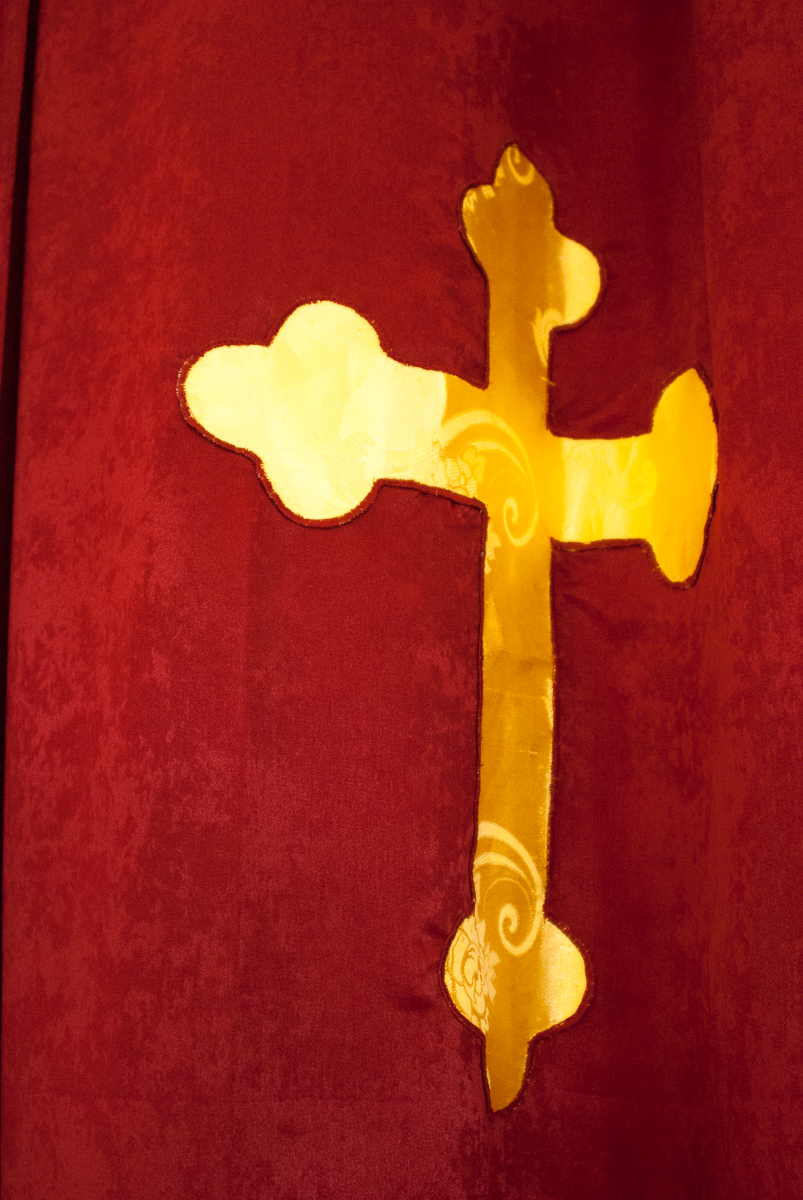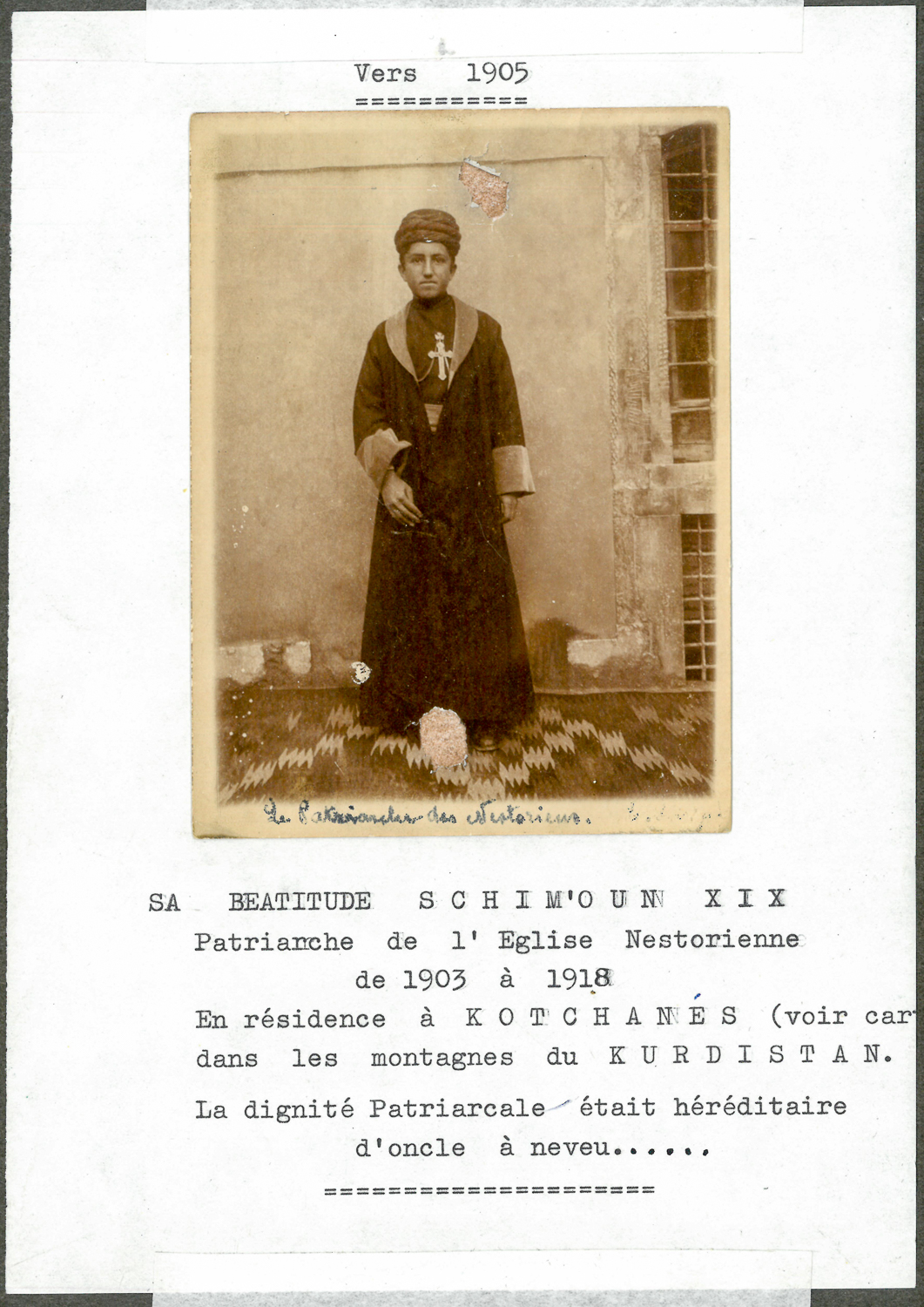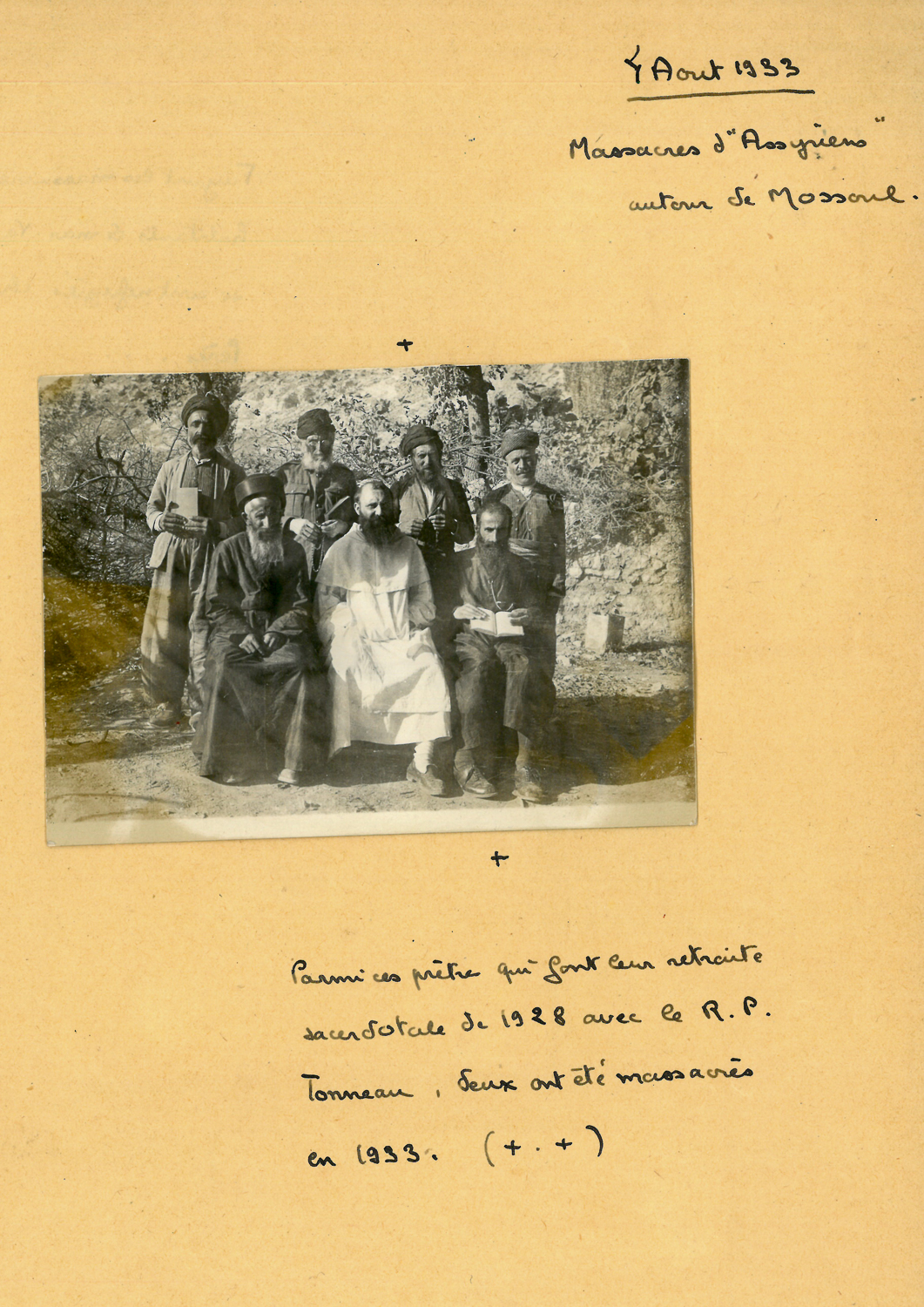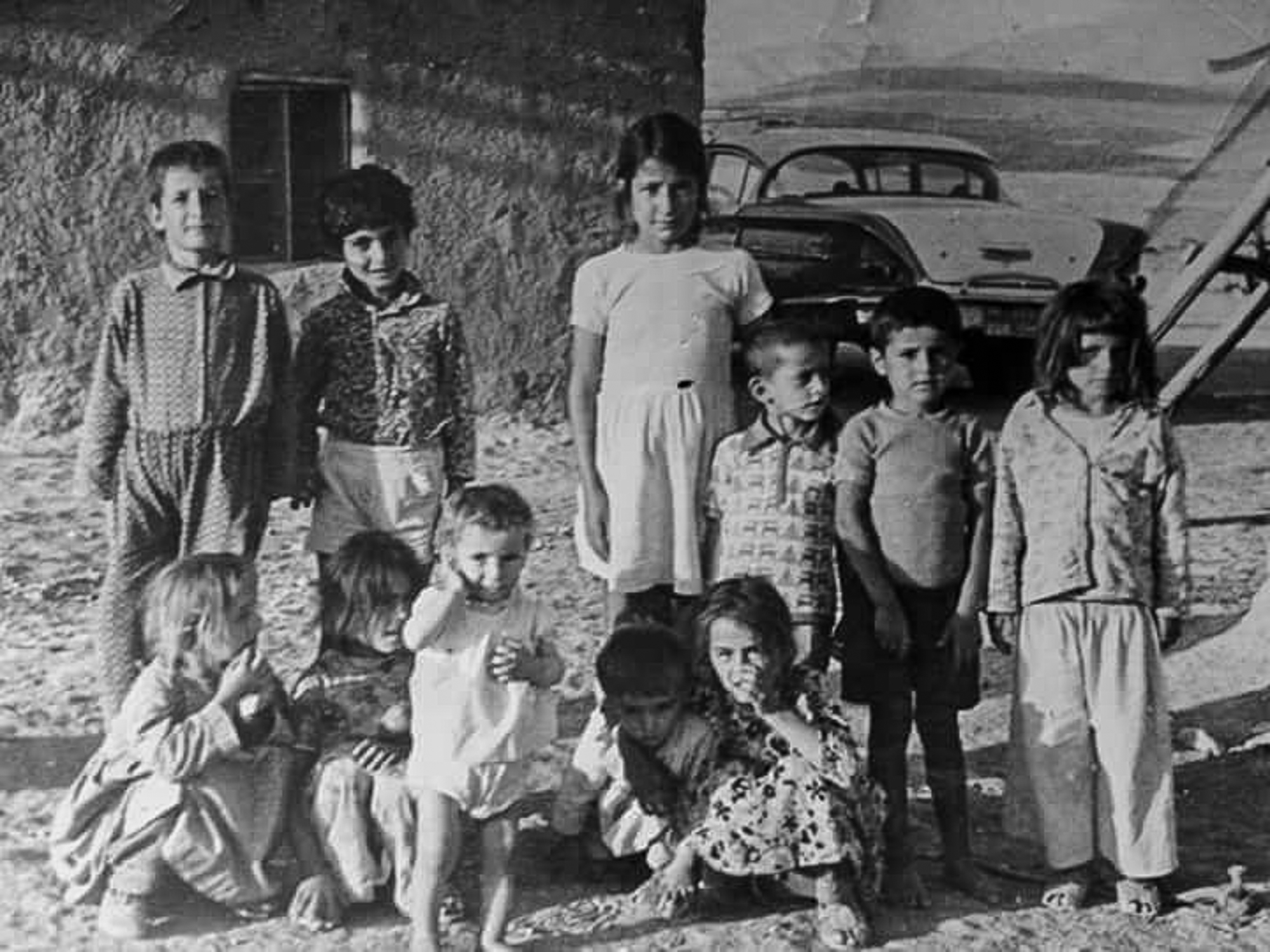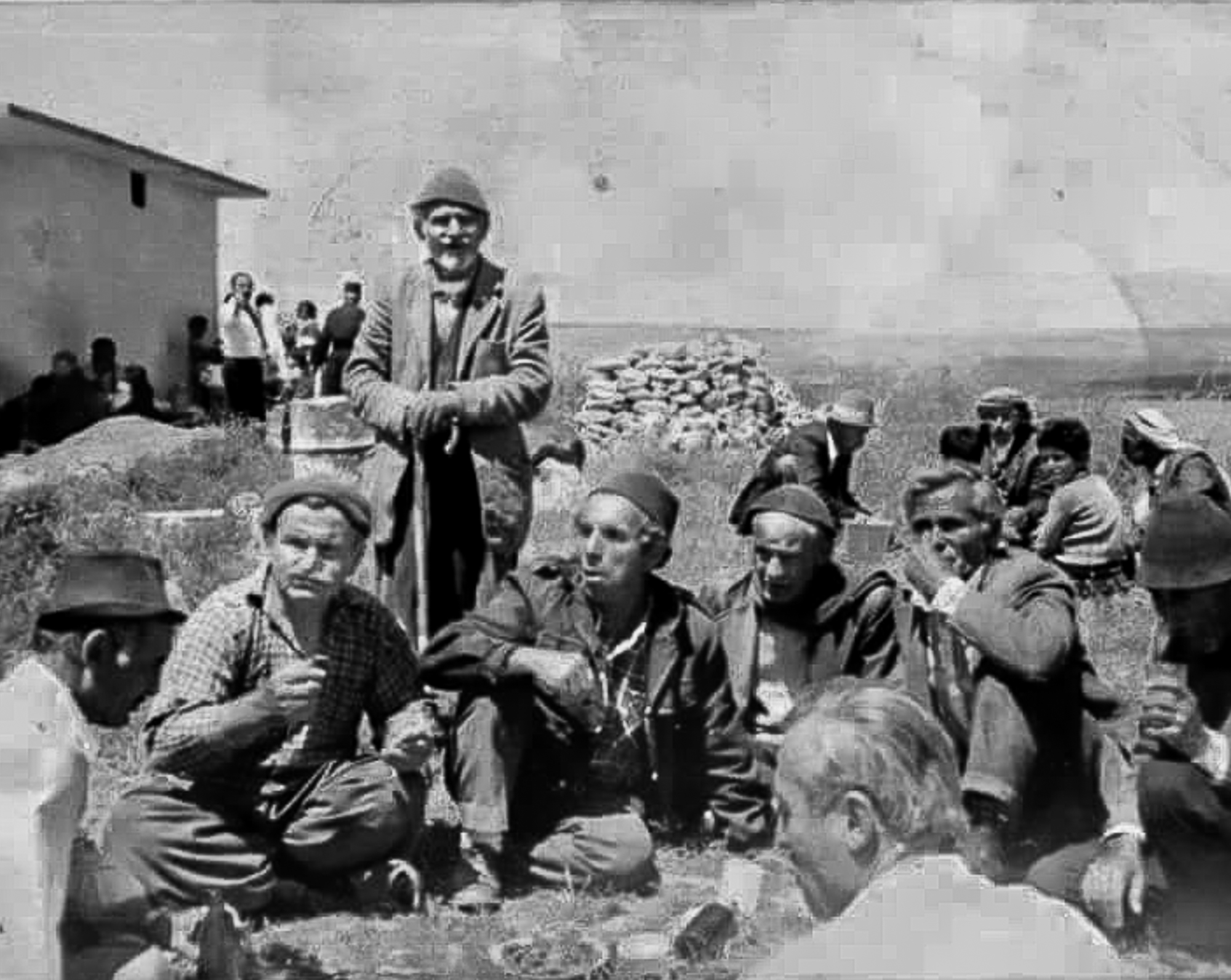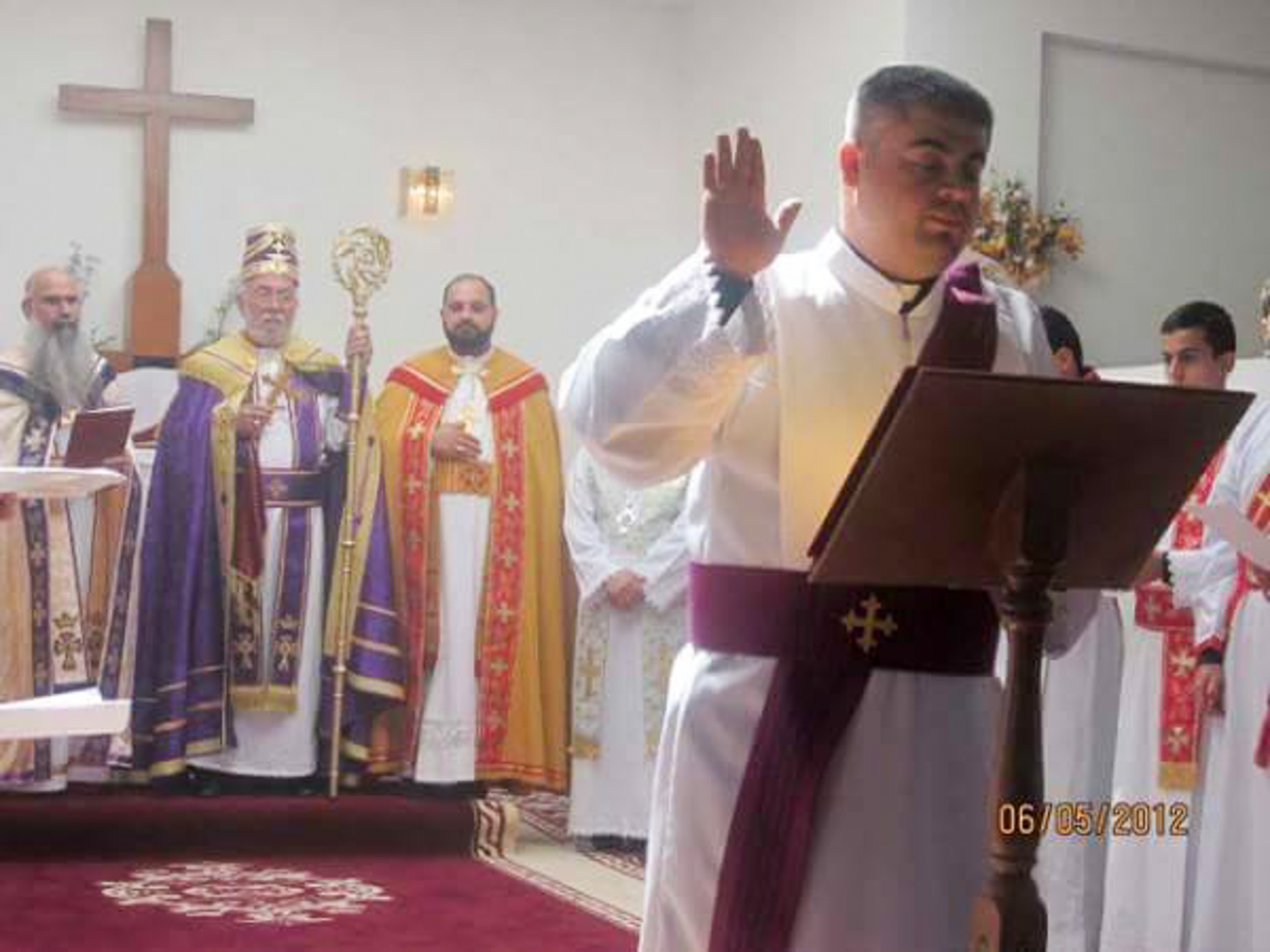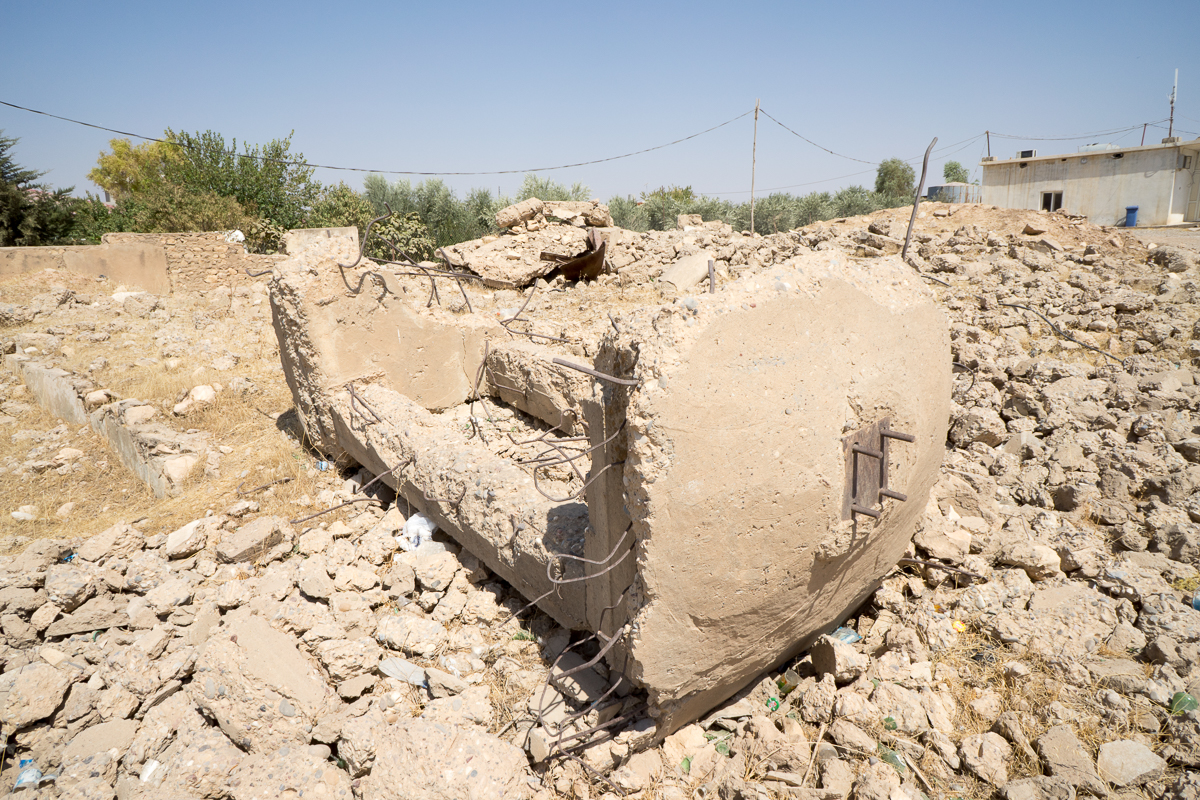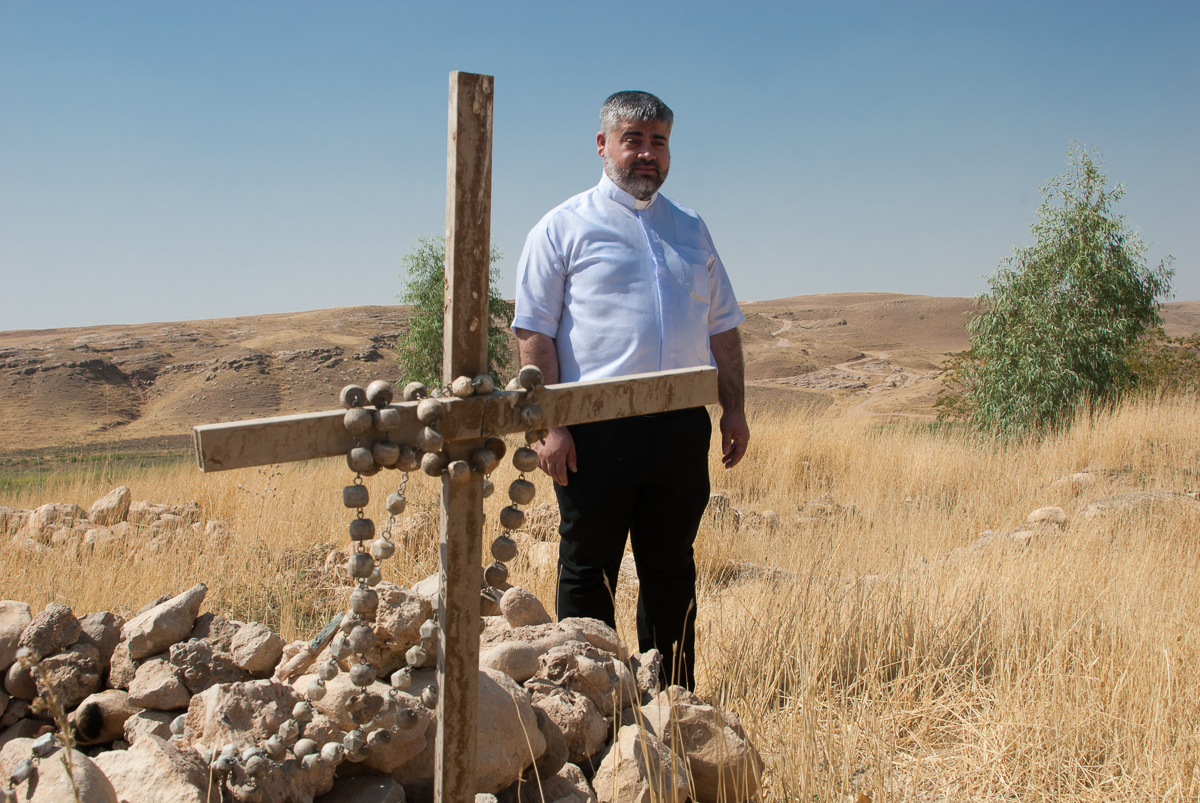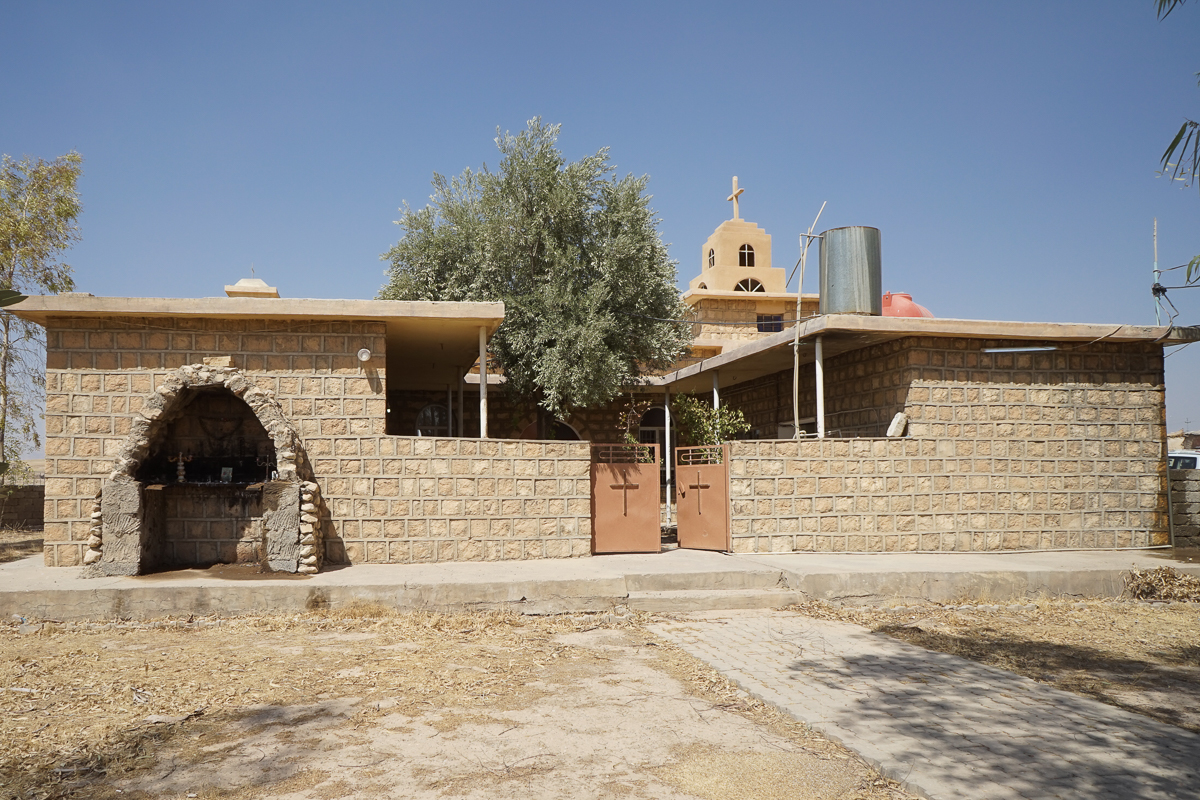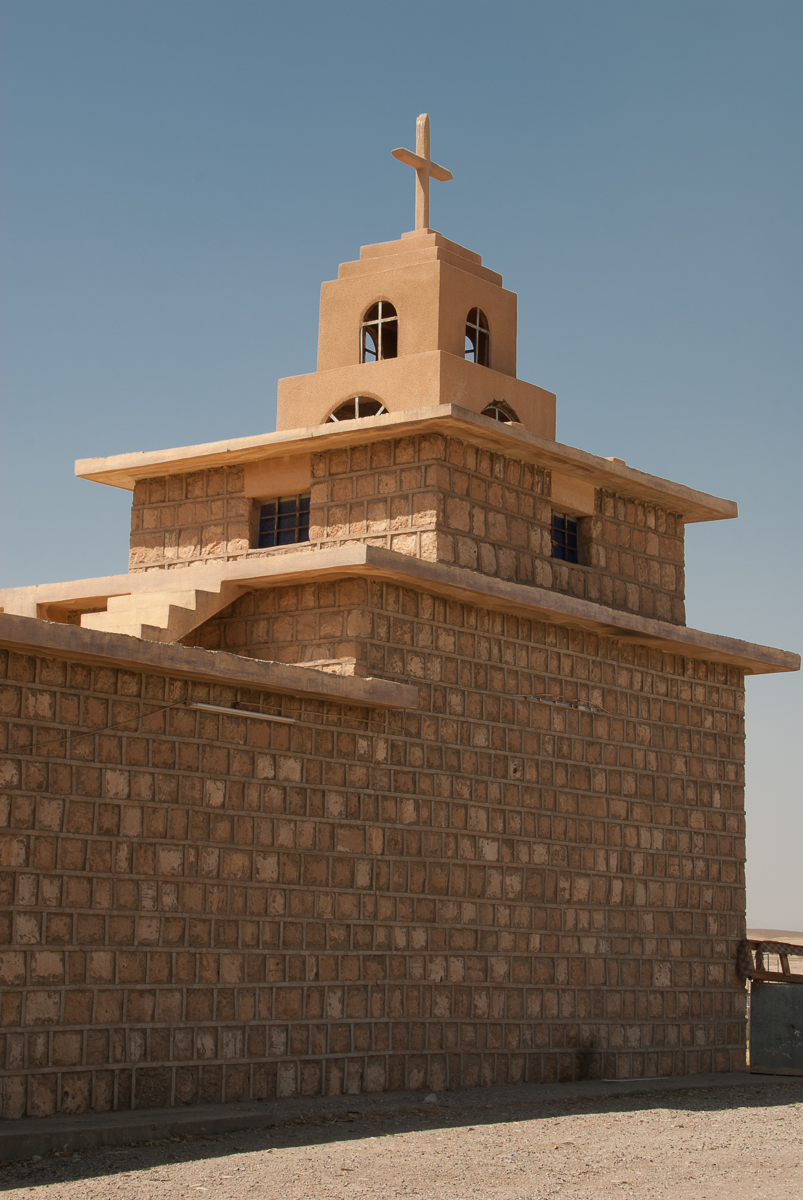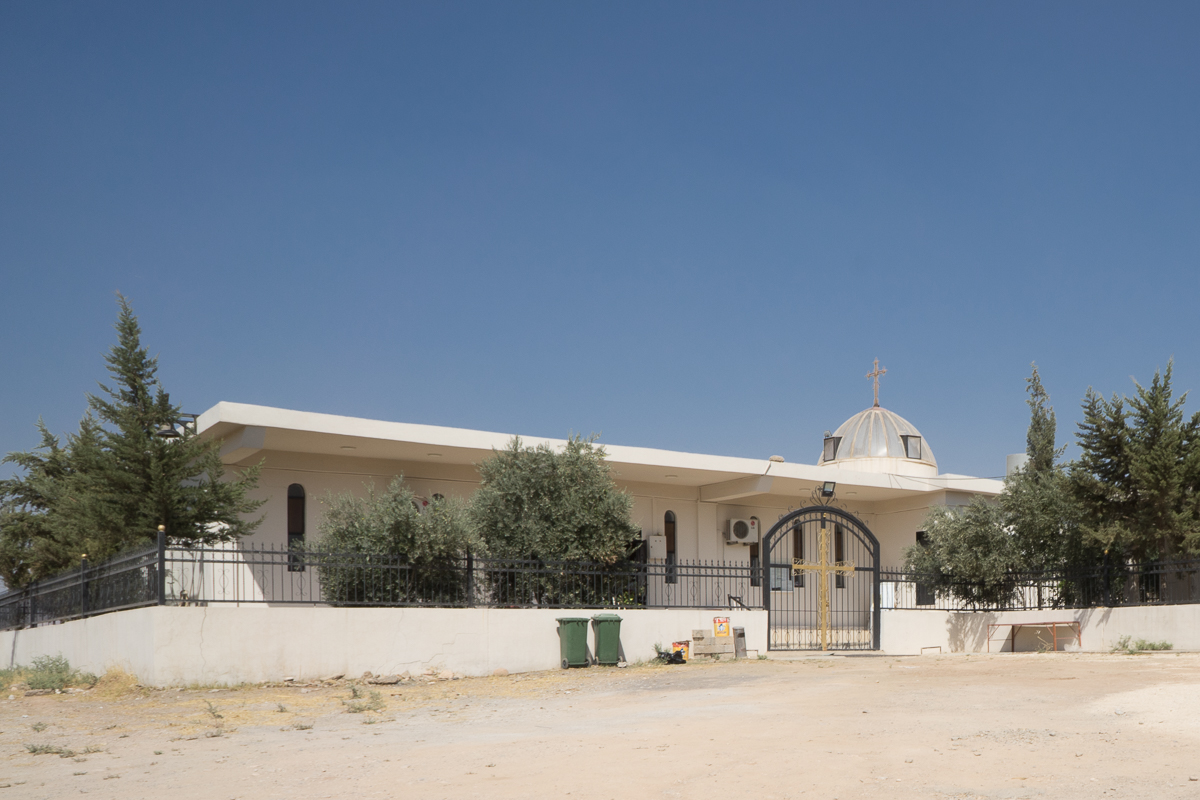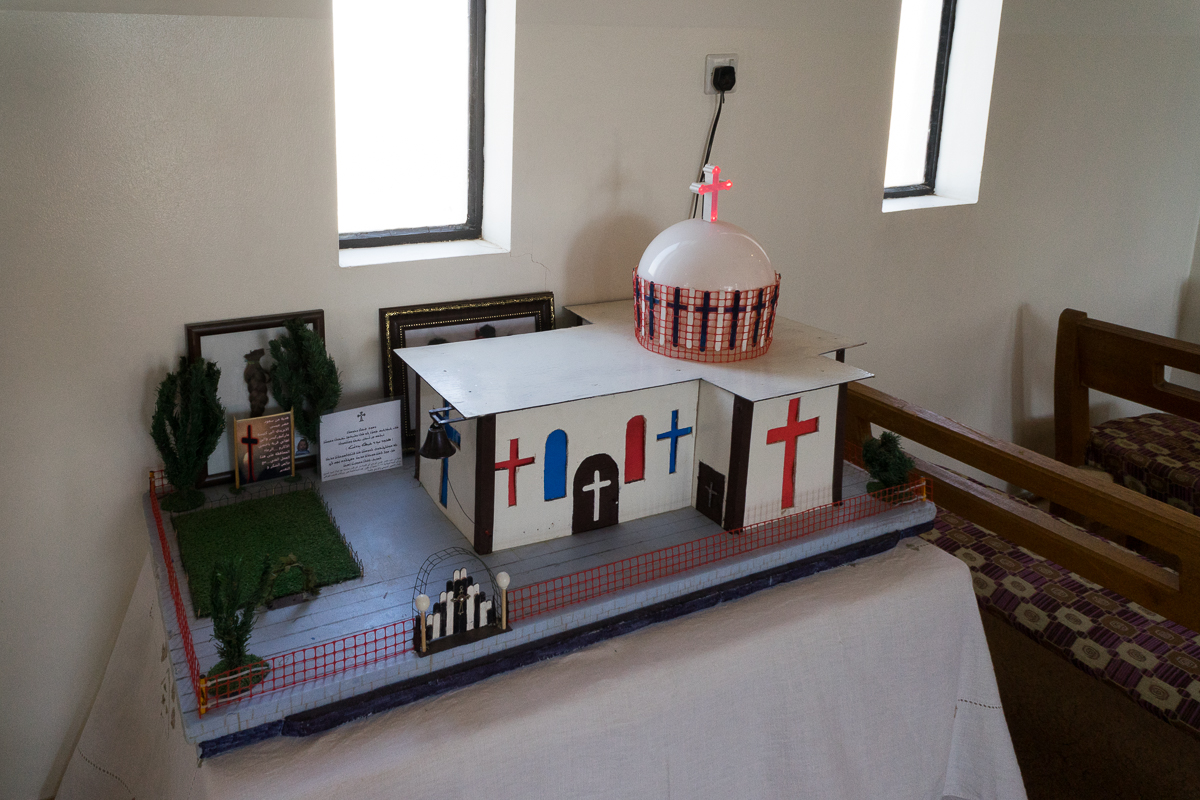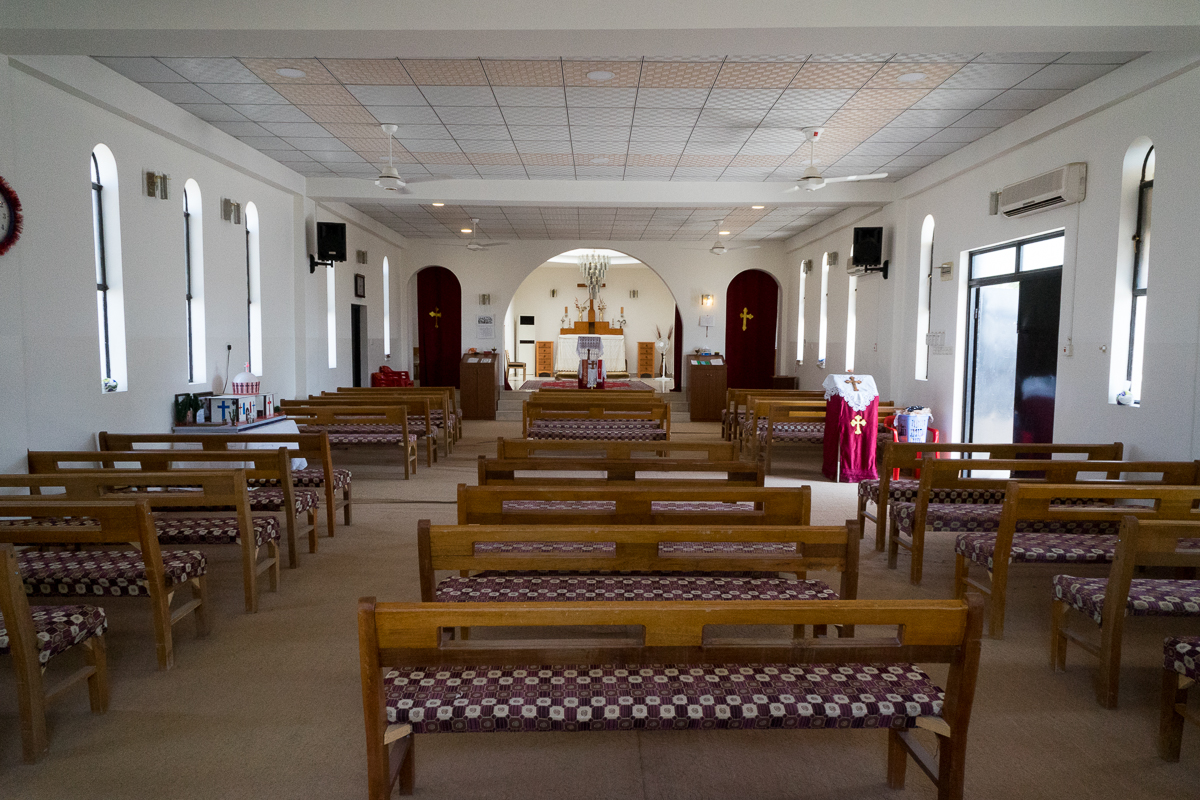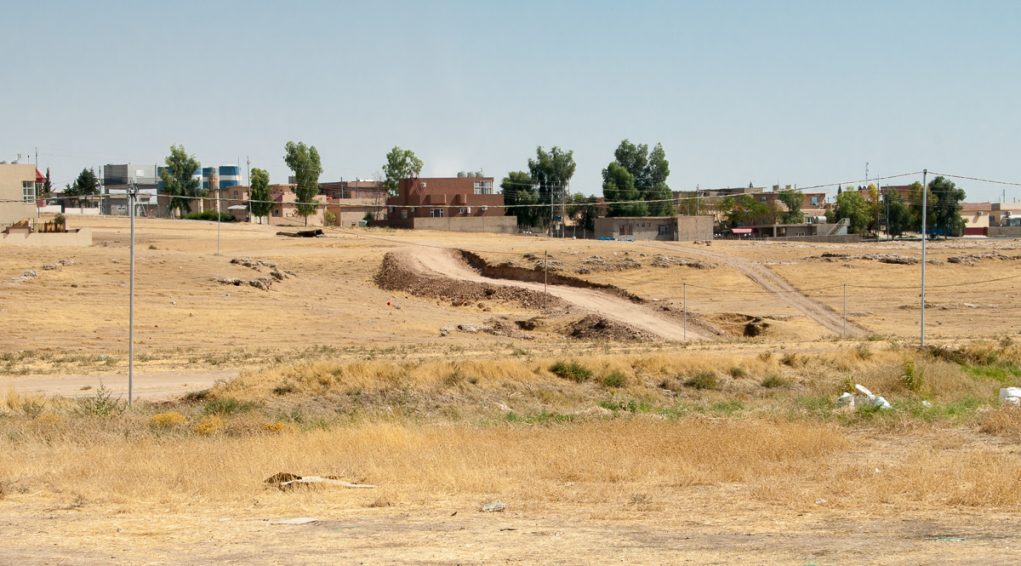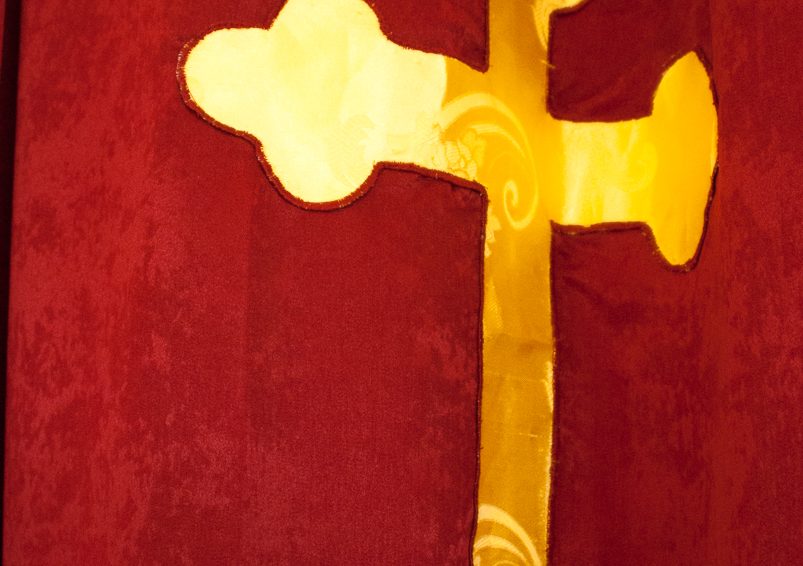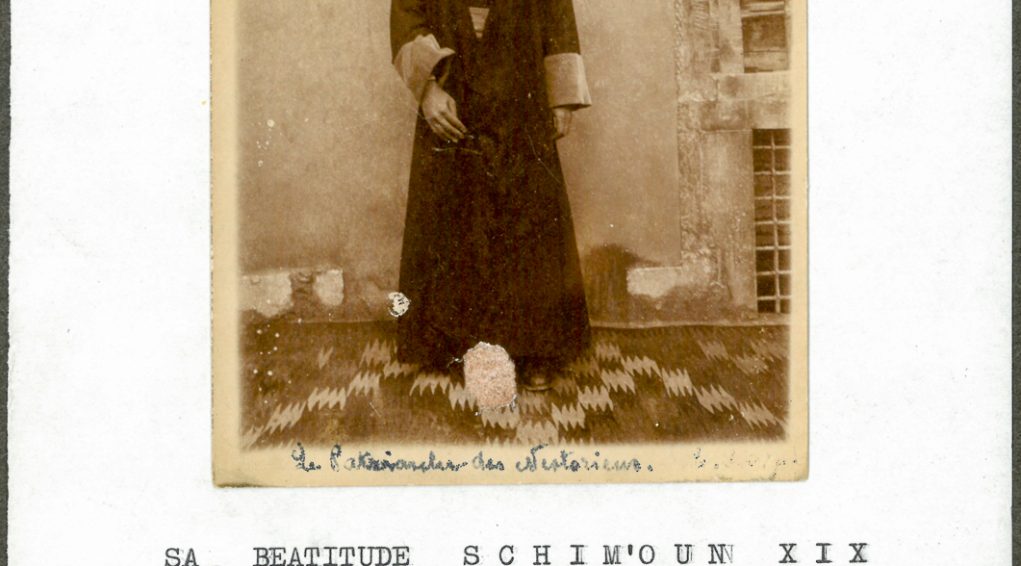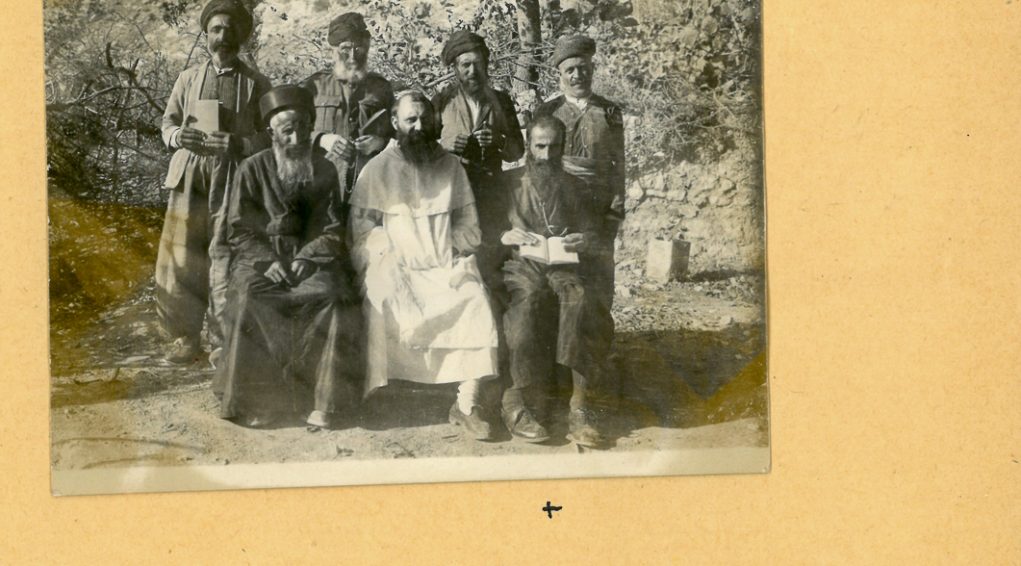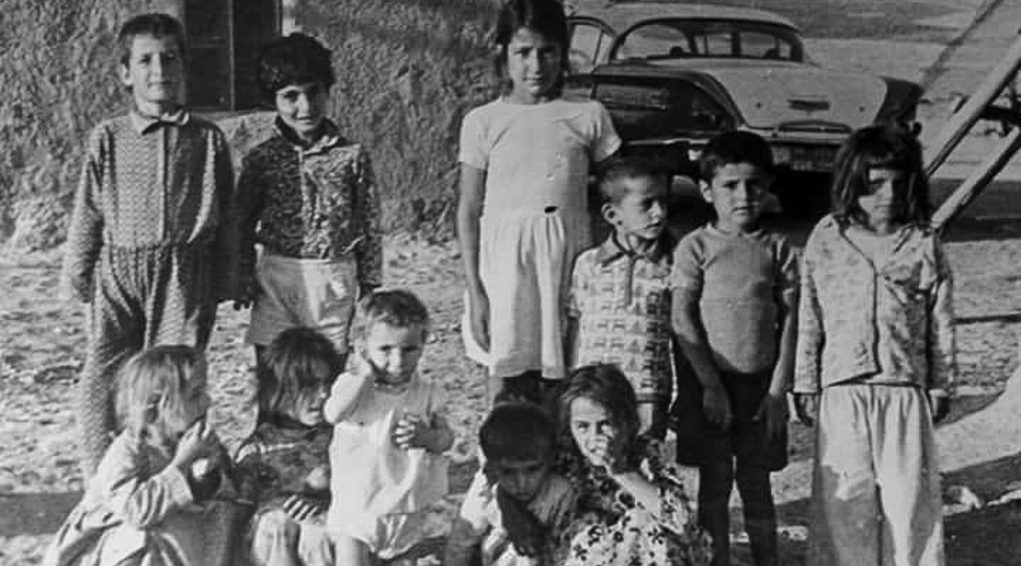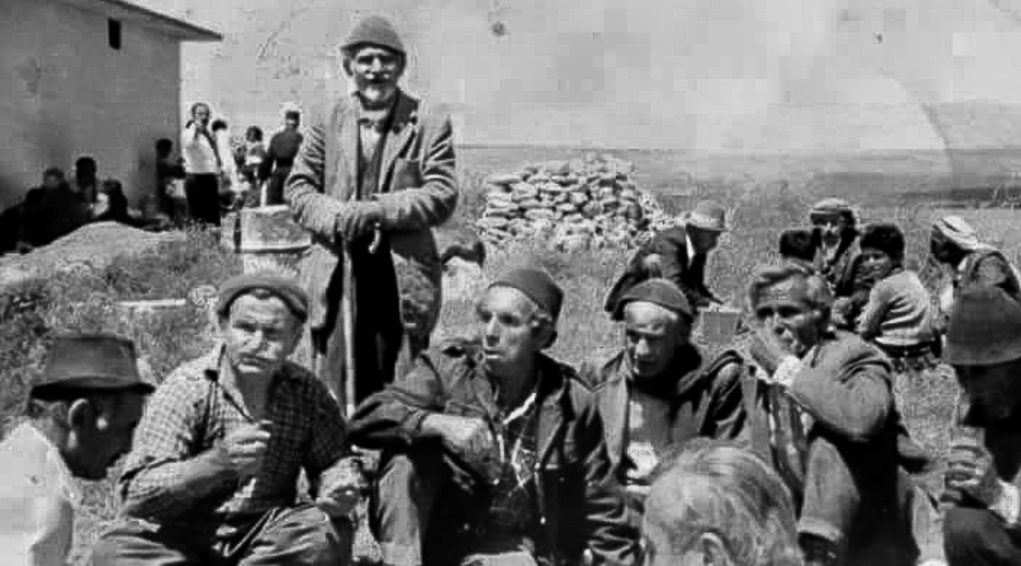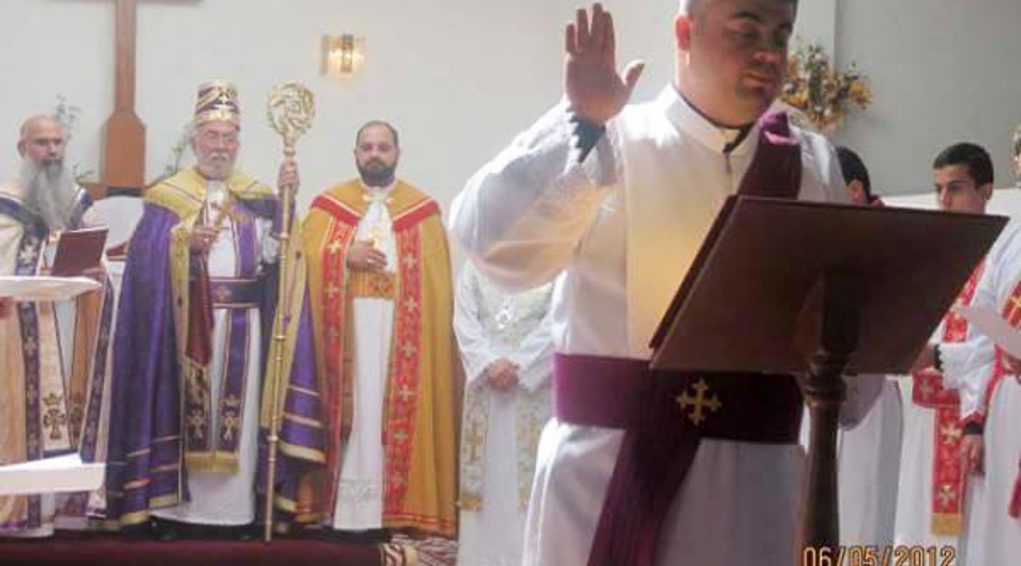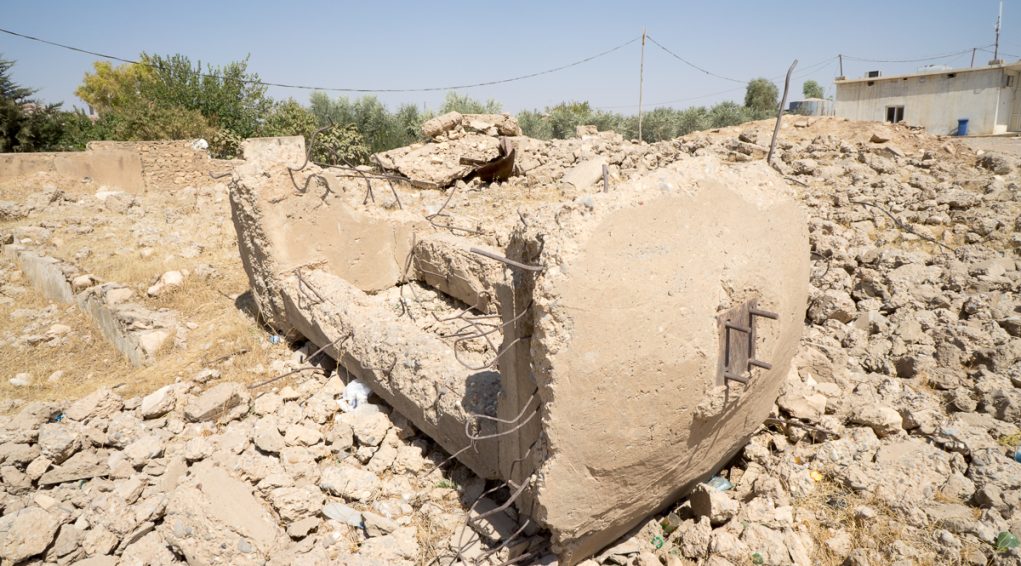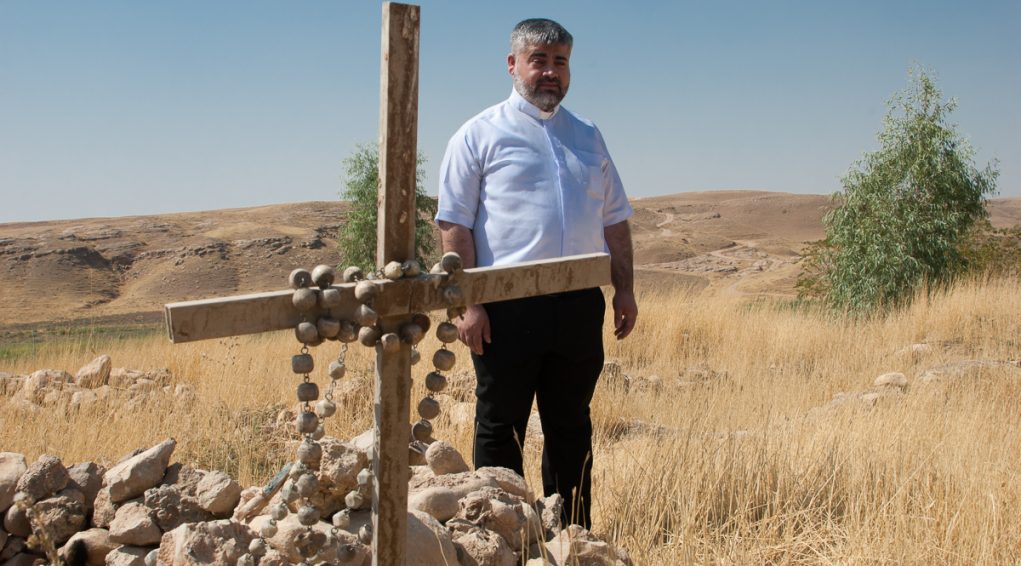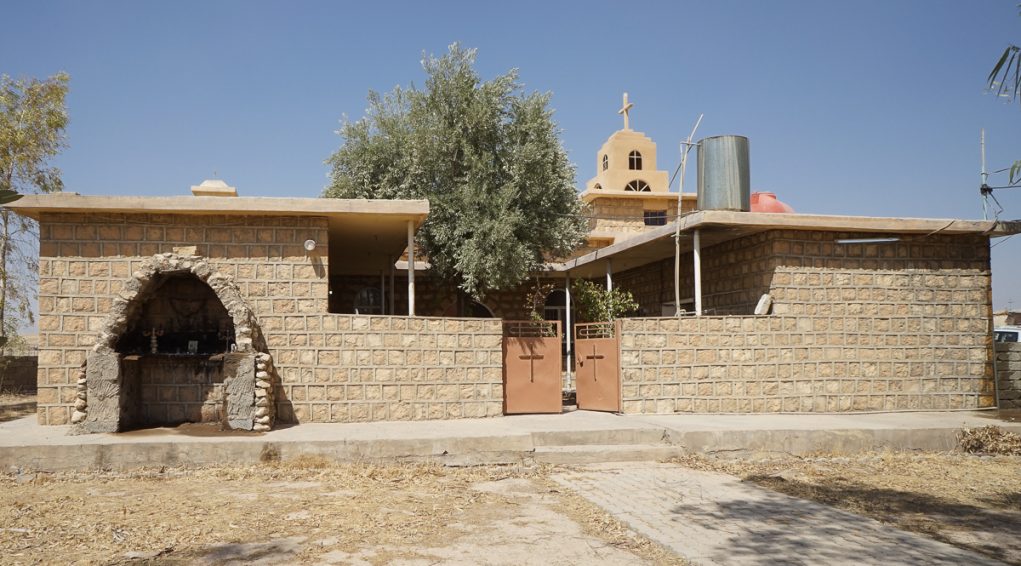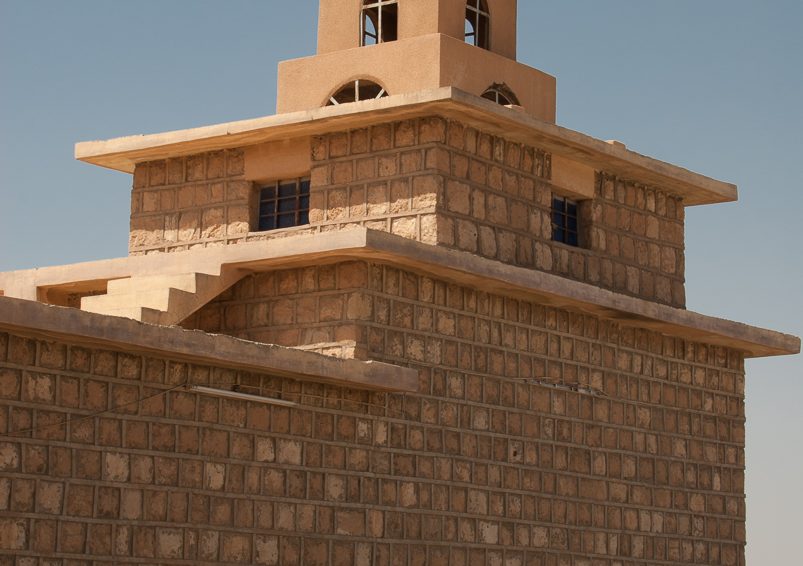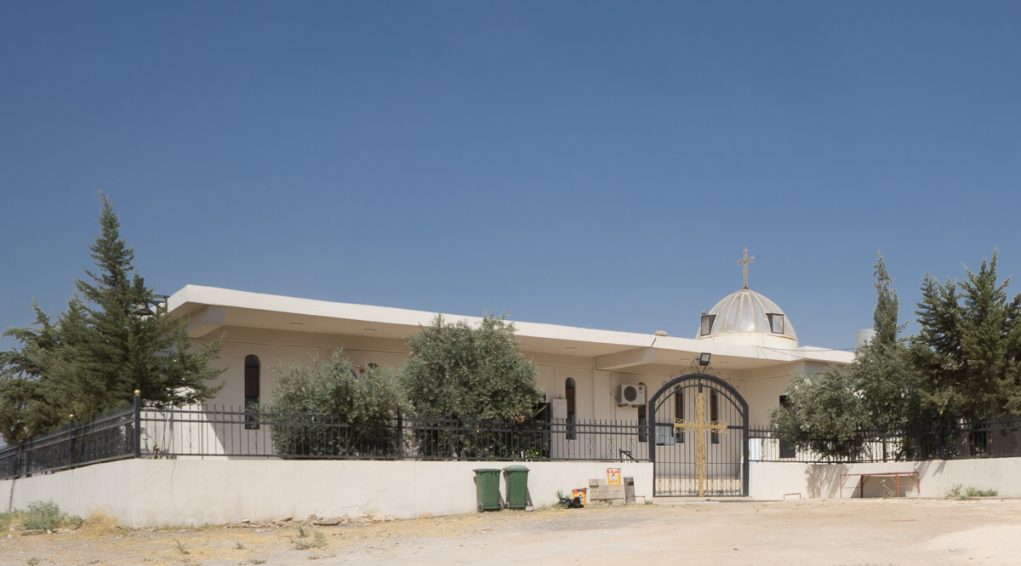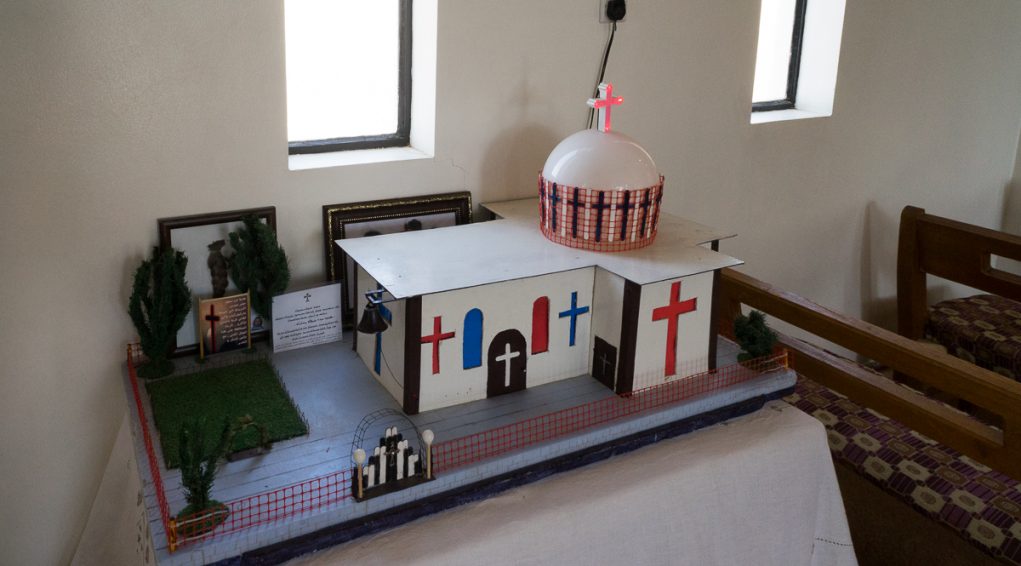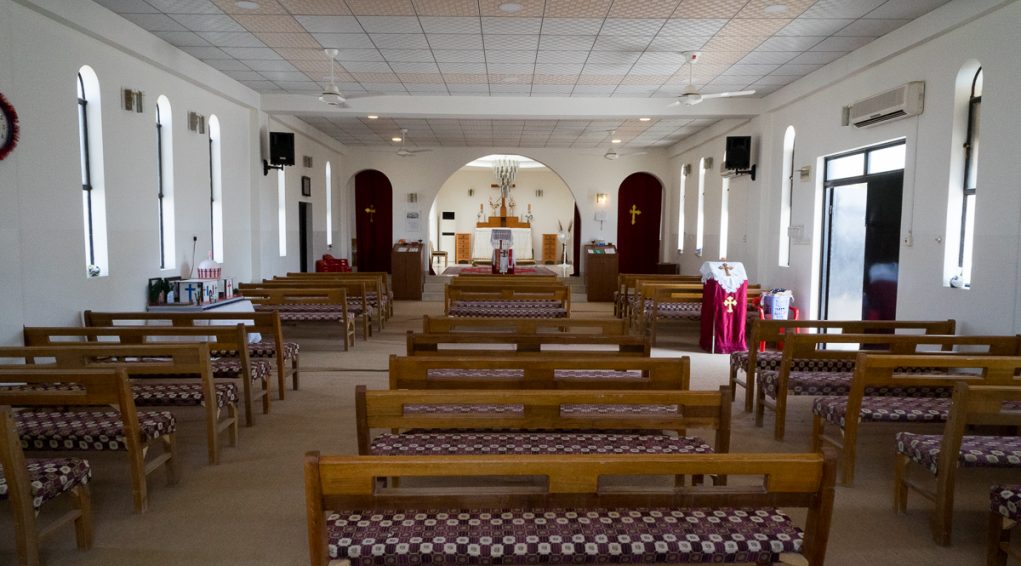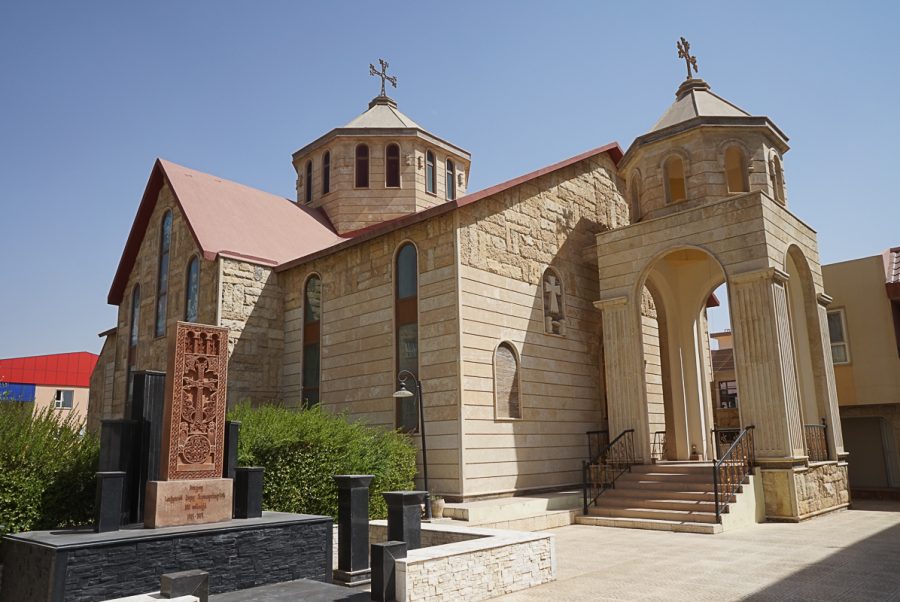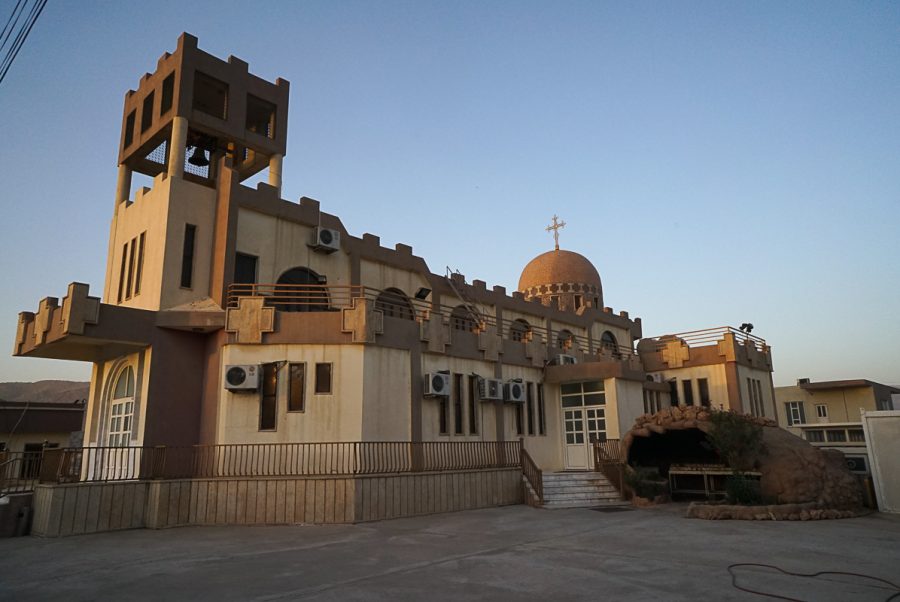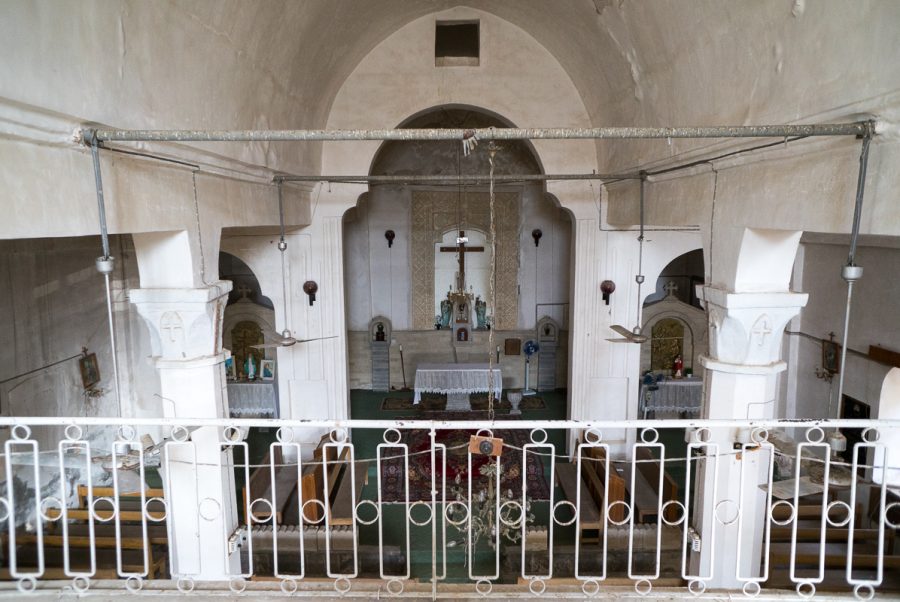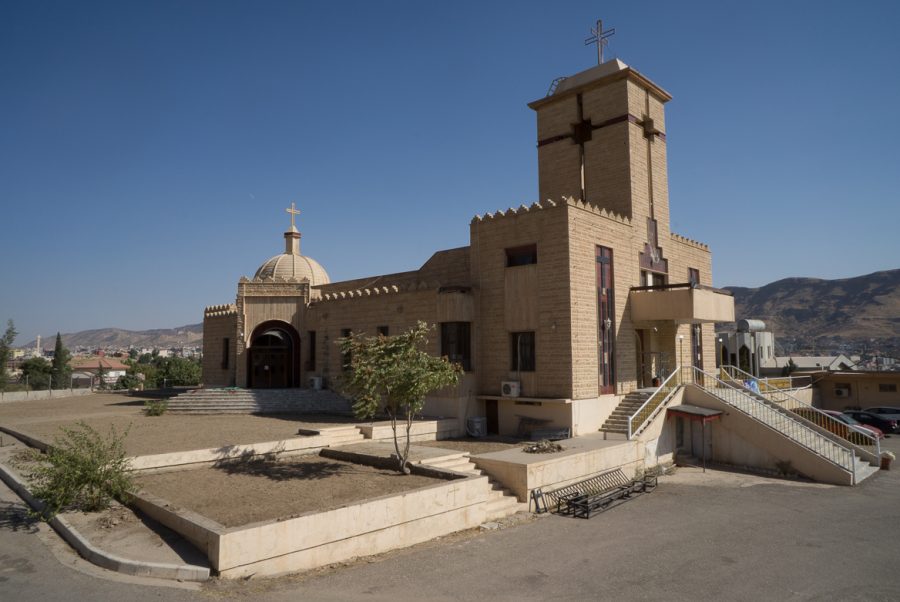The Mar Gorgis Church in Bakhetme
The (ancient) Mar Gorgis Holy Apostolic Catholic Assyrian Church of the East is located in the village of Bakhetmeat 36°48’30.3″N 42°51’40.1″E and 395 metres altitude.
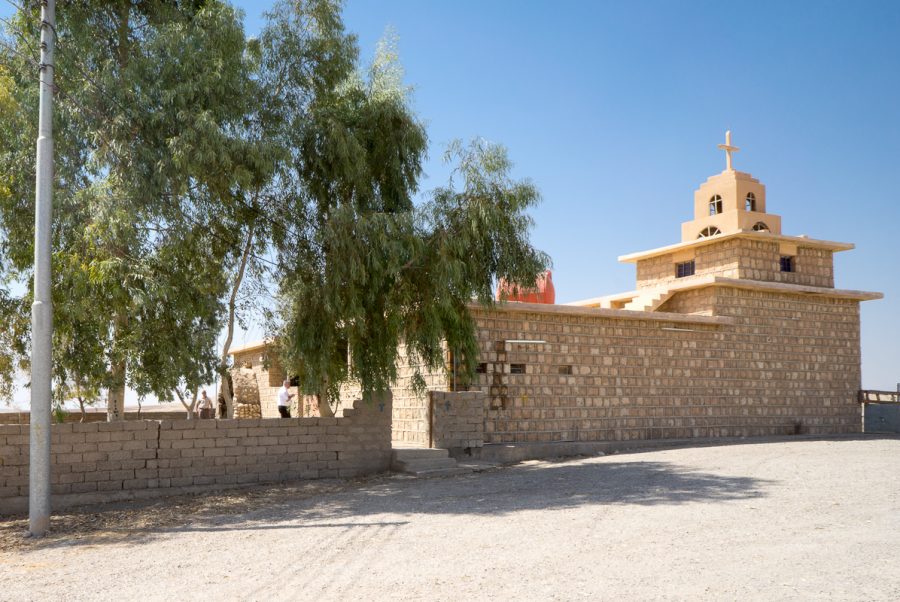
The village of Bakhetme is a very ancient Christian village. Still today you can see the ruins of a very ancient monastery named after Mar Daniel which the locals say dates from the 3rd century.
In 1920, under British rule, Christian families settled in Bakhetme but were forced to flee to Syria in 1933 due the Simele massacre of the Assyrian Chaldeans. After returning to Iraq, the tribal and religious leaders bought Bakhetme in 1958 for 160,000 dinar with financial assistance from the Assyrian and Chaldean Patriarchs. Just over 100 families were still living in Bakhetme in 2017.
There are two Mar Gorgis churches. The first wasrebuilt by a German foundation in 1996 and is now seldom used. The second built by Sarkis Aghajan in 2007 is used for all services.
Pic: The Assyrian Mar Gorgis church in Bakhetme. August 2017 © Pascal Maguesyan / MESOPOTAMIA
Location
The (ancient) Mar Gorgis Holy Apostolic Catholic Assyrian Church of the East is located in the village of Bakhetme at 36°48’30.3″N 42°51’40.1″E and 395 metres altitude.
The village is located 10 km south-west of Dohuk-Nohadra, 38 km north-west of Alqosh, 73 km north of Mosul and 155 km north-west of Erbil, the capital of Iraqi Kurdistan.
The names of the Holy Apostolic Catholic Assyrian Church of the East
The Holy Apostolic Catholic Assyrian Church of the East is known by several names. Here we will simply mention the “Church of the East” in opposition to the Church of the West; “Church of Assyria” and “Church of Meopotamia” which identify its members with these ancient civilisations; “Church of Persia”, as it was under the eponymous Empire that the Eastern Christians structured their geopolitical space and that so many were martyred; and the “Nestorian Church” as it was established by consent with the Christology of the patriarch of Constantinople Nestorius deposed at the Council of Ephesus in 431.
The official denomination Holy Apostolic Catholic Assyrian Church of the East is the most complete. Founded and legitimised by the apostle Thomas, the church is proud of its roots in ancient times and places an emphasis on its missionary work.
The name “Holy Apostolic Catholic Assyrian Church of the East” was the result of a division based on the choice of calendar: Gregorian or Julian. Those faithful to the Julian calendar formed the Holy Apostolic Catholic Assyrian Church of the East.
Origins of the Holy Apostolic Catholic Assyrian Church of the East
According to the tradition, the origin of the Holy Apostolic Catholic Assyrian Church of the East go back to the apostles and disciples including Thomas, Addai (some assert that Addai is also the disciple Thaddeus, also known as Jude) and Mari. The tradition also recounts that Thomas“stopped in Seleucia-Ctesiphon during his journey to India”.[1]
The new religion would have been specifically preached to local Jewish communities. “We have no sources regarding the circles that were concerned with evangelization; however it seems sensible to think that the first ones to convert were taken among Jewish population, very important in those times throughout Mesopotamia, and even beyond the Tigris River, from the days they had been deported to Babylonia by Nebuchadnezzar. Most likely the greatest efforts to convert people were focused on these Jewish communities, as it already was the case in all cities of the Roman Empire.”[2]
It was really from the 4th century on that the Holy Apostolic Catholic Assyrian Church of the East started structuring itself in Seleucia-Ctesiphon and almost simultaneously the Persian King Shapur II ushered in an era of anti-Christian persecution, resulting in large numbers of martyrs who are still worshipped centuries later.
In the 5th century, the conflict between the Roman Empire and the Persian Empire, along with Christological disputes between schools of theology, widened the gap between the Churches of the West and the East. After having rejected the conclusions of the Council of Ephesus (431) and welcomed in the patriarch Nestorius, the Church of the East confirmed its break with Rome and Constantinople and asserted its autocephalous nature. This was the second act in the birth of the Church of the East, after it was founded by Saint Thomas.
_______
[1]In « Histoire de l’Église de l’Orient », Raymond le Coz, published by Éditions du Cerf, 1995, p.21
Fragments of history: The Assyrians from the 16th to 21st century
In the 16th century, the schism within the Holy Apostolic Catholic Assyrian Church of the East, engendered the Chaldean Church (in communion with Rome) and caused a major upheaval. The majority of Christians in the Apostolic Assyrian Church of the East progressively turned to the Chaldean Catholic Church, The consequences of this schism were such that the great Church of the East of the first centuries became “at the end of the Middle Ages, a mere Church-nation”[1], isolated in the mountainous border regions of the Persian (north-west Iran) and Ottoman (extreme south-east of Turkey and north of Iraq) Empires.
Under Ottoman domination through the 19th century, Kurdish tribes pillaged Christian villages, killing and kidnapping the inhabitants. In 1843 – 1847 the massacres committed were truly horrendous: “The Kurdish Emir of Bohtan Béder-Khan butchered the Assyrians and Chaldeans in the province of Van. Over 10,000 men were massacred, thousands of women and young girls kidnapped and forced to covert to Islam, all the Assyrians’ and Chaldeans’ possessions and villages were burned to the ground”[2].In 1894-1896 the nature of the massacres of the Christians (Armenians, Assyrians, Chaldeans and Syriacs) changed. These were organised at the highest levels of the empire by Sultan Abdul Hamid II, known as the Red Sultan, who sent out his hamidiyé to attack Christian localities. This genocide left the Christian communities almost wiped out of existence.
When the nationalist Young-Turk revolution overthrew the Sultan in 1908, Christians in the Empire were filled with a last gasp hope for a change in fortunes. This was illusory. As of 1909, the Adana massacres constituted the prelude to the systematic, planned destruction of the Christian communities, carried out under the cover of the First World War from 1915 – 1917. From the very start of the war, in the autumn of 1914, Turkish and Kurdish troops entered into Persia and massacred the Assyrian and Chaldean communities in the Ourmiah district. In April 1915, when the genocide of the Armenians began in the eastern provinces of the Ottoman Empire, 150,000 Assyrian survivors grouped together in the Hakkari mountains (extreme south-east of Turkey) from the vilayetof Van around the patriarchal seat of Kotchanes[3](since 1662), residence of the Catholicos Mar Schemoun “member of the family of the same name, guarantor of the traditions and nepotism exercised within it since 1450[4]”. The Hakkari Assyrians resisted their Turkish and Kurdish attackers ferociously, but were forced into exile in Persia. “They crossed the high mountains towards Salmas in Iran on 7 – 8 October 1915. The survivors, 50,000 out of 100,000 arrived exhausted[5]. They were taken in by the Russian army and their compatriots (…) But the local population was against them and their compatriots living there were ruined.” From 1915 to 1917, the massacres of the Armenians, Syriacs, Chaldeans and Assyrians continued and intensified, spreading to all the towns and villages in the Ottoman provinces of Van, Bitlis, Mamuretulaziz, Erzeroum, Diyabakir and Aleppo. These horrific massacres led to a mass exodus which killed even more people as they headed for the deserts of Syria and Mesopotamia. During the summer of 1918, abandoned by their Russian protectors “around eighty thousand Assyrians and Chaldeans, with their cattle and their belongings[6]”once again took to the road from Ourmiah, towards Hamadan in Persia, before finally arriving in Mesopotamia in Bakouba (50 km north-east of Baghdad). Half of the displaced population perished during this further ordeal.
In Mesopotamia under British rule, the Assyrians were used as combat troops, the Assyrian Levies,who helped to maintain order whilst hoping this would see them awarded political favours for the Assyrian Chaldean nation. “Rather than a State, the still-born treaty of Sèvres signed on 10 August 1920, signed between Turkey and associated allied powers, only afforded the Assyrian-Chaldeans guarantees and protection as part of a future autonomous Kurdistan. The treaty never came into force.[7]” The 6,500 Assyrians commanded by General Agha Petros could only count on themselves and attempted to take back Hakkari in October 1920, but this degenerated into a punitive and ultimately fruitless expedition. In 1923, the Lausanne treaty killed off the Assyrians’ and Armenians’ illusions of autonomous rule, simultaneously ruling out any chance of return. When the British mandate came to an end and Iraq became independent on 3 October 1932, the Iraqi authorities wanted to disperse the Assyrian Chaldeans. The Assyrians refused and entered into resistance. A thousand of them took up arms and travelled to Syria which was under French rule at this time, in July 1933, with a view to negotiating the collective, long-term settlement of their community. When they returned to Iraq at the beginning of August, via the village of Faysh Khabur to meet up with their families, the Assyrian fighters were shot down by King Faisal’s troops, but they managed to defeat the Iraqi forces. This affront caused Iraqi troops to take their revenge against the Assyrian-Chaldean villagers of Simele, close to Dohuk. The massacre began on 8 August 1933, with help from the Kurdish tribes. Three thousand men, women and children had been killed by 11th August. “The Arab officers and soldiers who committed these crimes were promoted and received a triumphant welcome in Mosul and Baghdad; their leader, the Kurdish Colonel Baker Sedqi, was made a General.”[8]
The rest of the 20th century was not much better for the Assyrian-Chaldeans. During the Second World War, new Assyrian combat units contributed to the British war effort against an Iraqi government supported by Nazi Germany. They obtained no diplomatic rewards. As of 1961, and up until 2003, the successive civil wars opposing Kurdish separatists and the Baghdad government had an appalling effect on the Assyrian-Chaldean Christian communities in the north of the country: killings, blackmail, destruction of heritage, forced population displacements, forced Arabisation, gas attacks etc. In 2003, end of the tyrannical regime of Saddam Hussein, marked the start of a chaotic period of Islamism and organised crime, during which criminal groups such as Al-Quaeda and ISIS persecuted Christian communities. Against all expectations, in the Kurdish mountains, the Assyrians and other Christians of Iraq benefited from a historic period of respite, thanks to the benevolence of the Kurdish regional government which implemented policies favouring the reinstallation of native-speaking Christian communities. The Church of the East could finally look to the future.
The Holy Apostolic Catholic Assyrian Church of the East has undergone a further schism since 1964. This concerned the calendar of reference. The vast majority of Assyrians chose to use the Gregorian calendar, in communion with the other Christians in the region. Those who remained faithful to the Julian calendar formed the Ancient Holy Apostolic Catholic Church of the East. This separation did not alter the sense of belonging to one and the same Church.
_______
[1]In “Du génocide à la diaspora : les assyro-chaldéens au XXesiècle”, Joseph Alichoran, Article published in the review Istina, 1994, N°4, October-December, p.4
[2]Eugène Griselle in “Qui s’en souviendra ? 1915 : le génocide assyro-chaldéo-syriaque.”, Joseph Yacoub, Les éditions du Cerf,, p.128
[3]In 1988, nothing remained of this patriarcate other than the patriarchal church Mar Shallita, built in 1689 and in poor condition. What remains in 2018? Source Joseph Alichoran.
[4]In “Du génocide à la diaspora : les assyro-chaldéens au XXesiècle”, Joseph Alichoran, Article published in the review Istina, 1994, N°4, October-December, p.5
[5]Eugène Griselle in “Qui s’en souviendra ? 1915 :le génocide assyro-chaldéo-syriaque.”, Joseph Yacoub, Les éditions du Cerf,, p.149
[6]In “Du génocide à la diaspora : les assyro-chaldéens au XXe siècle”, Joseph Alichoran, Article published in the review Istina, 1994, N°4, October-December, p.22
[7]In “Du génocide à la diaspora : les assyro-chaldéens au XXe siècle”, Joseph Alichoran, Article published in the review Istina, 1994, N°4, October-December, p.24
[8]In “Du génocide à la diaspora : les assyro-chaldéens au XXe siècle”, Joseph Alichoran, Article published in the review Istina, 1994, N°4, October-December, p.29
Assyrian demographics in Iraq
At the end of the 19th century and on the eve of the First World War, the Assyrian nation was estimated at one million people in Iraq, Iran and Turkey. In 1957, there were 750,000 to 1 million in Iraq. At the start of the 1970s, this figure fell to 300,000. In 2017, there were less than 40,000. This demographic collapse is the consequence of a series of historic disasters.
The main Assyrian populations in Iraq are found in Dohuk-Nohadra where there are 2,000 families. Around Dohuk-Nohadra, in the districts of Barwar, Simele, Zakho and Amadia, there are 1,500 families spread across 55 villages. In total, the province of Dohuk-Nohadra is home to around 20,000 Assyrians.[1]
Four major monasteries of the Holy Apostolic Catholic Assyrian Church of the East remain: Mar Audicho’ in Déré, Mar Qayouma in Kani Massi Douré, Mar Gewarguis in Kani Massi Iyed and Mar Mouché in Kani Massi Tchélèk.
_______
[1]Source: Khoury Philippos, archpriest of the Mar Narsaï church in Dohuk-Nohadra part of the Holy Apostolic Catholic Assyrian Church of the East.
History of the village of Bakhetme
The village of Bakhetme is a very ancient Christian village. Still today you can see the ruins of a very ancient monastery, which the locals say dates from the 3rd century[1], named after Mar Daniel also known as Mar Daniel Tobib / Saint Daniel the Physician, celebrated on the first Sunday of the month of May.
The name of the village means the “house of seals”. This dates back to the time of the Turkish-Ottoman empire when the town was an administrative centre where documents were sealed.
The ancestors of the inhabitants of Bakhetme belong to the Nochiya clan. These Assyrian Christians come from Tyari in the Hakkari mountains (see Fragments of history).
In 1920, under British rule, Christian families settled in Bakhetme but were forced to flee to Syria in 1933 due the Simele massacre of the Assyrian Chaldeans.
After returning to Iraq, the tribal and religious leaders bought Bakhetme in 1958 for 160,000 dinar with financial assistance from the Assyrian and Chaldean Patriarchs. Everyone had to contribute according to their means.
Initially, 65 families settled here. Farmers arrived and started out by growing tomatoes, wheat and barley. The first school was set up in 1959.
For four years, mass, sacraments, and services were celebrated in houses. In 1960, a small church named after the Virgin Mary was built, followed in 1961 by the first Mar Gorguis church, then in 1980 a new church named after Mar Daniel. Mar Gorguis is the largest of these three churches.
On 1st May 1987, Saddam Hussein sent bulldozers in to destroy the village, as he also did in 1975 in other villages to contain Kurdish separatism and Arabise the region. The inhabitants of Bakhetme were forced to leave and went to a new urban centre in Mansouriya in the area of Simele. The Mar Gorguis church, along with the early Christian Mar Daniel monastery was destroyed in 1988 during operation Anfal (bombing of Kurdish and Assyrian Chaldean villages with chemical weapons).
In 1996, a new Mar Gorguis church was rebuilt by a German organisation on the site of the church that had been destroyed.
After the fall of Saddam Hussein, in 2003, and the return of Assyrian families originally from Bakhetme in 2006, the Kurdish government financed the construction of 151 new houses in Bakhetme, thanks to Sarkis Aghajan, Christian benefactor and former Minister of the Economy and Finance. This led to a second Mar Gorguis church being built and consecrated in April 2007.
Just over 100 families still live in Bakhetme.[2]
_______
[1]Source: Father Guorguis Yaco, archpriest of Bakhetme, of the (ancient) Holy Apostolic Catholic Assyrian Church of the East.
Description of the two Mar Gorguis churches in the village of Bakhetme
There are two Mar Gorgis churches. The first was rebuilt by a German foundation in 1996 and is now seldom used. The second built by Sarkis Aghajan in 2007 is used for all services.
The Mar Gorgis church built by the Germans : The church is contained in a closed off space and has a magnificent panoramic view to the south and the west. Against the perimeter wall to the south-west is a small prayer oratory.
The church is composed of jointed stones. Its flat multi-level roof is made of reinforced concrete. Its outside appearance is reminiscent of a ziggurat, with its step structure from the base up to the summit of the dome to the east. There is a small bell tower on the roof to the west.
A metal gate to the south opens up onto a small, shady courtyard, at the back of which is the entrance door to the church.
The interior architecture is that of a single nave church in the form of a hall, 27 metres long by 8 metres wide. The vault is flat. The north and south walls are perforated with semi-circular windows.
The sanctuary is separated from the nave by a holy door with three openings formed of semi-circular arches fitted with curtains. The middle door is wider and slightly higher than the two side doors. The high altar backs onto the eastern wall.
Either side of the high altar as two traditional chambers, the sacristy on one side and the baptistery on the other.
The Mar Gorgis church built by Sarkis Aghajan: This is a modern church made of reinforced concrete, with a flat roof. The most surprising part of the church is its drum dome. The dome is entirely made of glass, allowing large amounts of natural light into the sanctuary.
A metal gate to the south opens up onto the building’s courtyard. The main door of the church is on the south facade. The interior architecture is that of a single nave church in the form of a hall, 27 metres long by 8 metres wide. The vault is flat. The north and south walls are perforated with semi-circular windows.
The sanctuary is separated from the nave by a holy door with three openings formed of semi-circular arches fitted with curtains. The middle door is wider and slightly higher than the two side doors. The high altar backs onto the eastern wall. Either side of the high altar are the two traditional chambers, the sacristy on one side and the baptistery on the other.
A small prayer altar has been erected to the north of the village, on the site of the ruins of the ancient Mar Daniel monastery.
Monument's gallery
Monuments
Nearby
Help us preserve the monuments' memory
Family pictures, videos, records, share your documents to make the site live!
I contribute